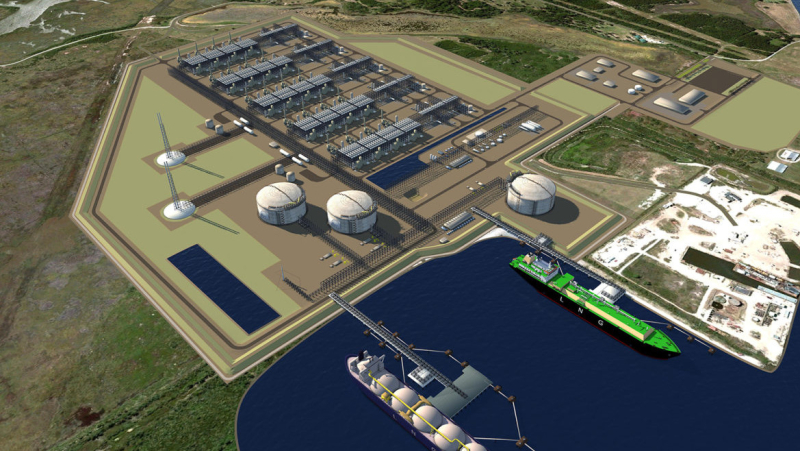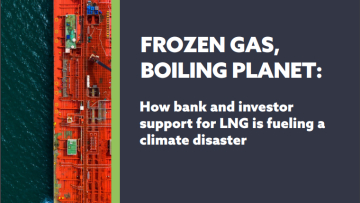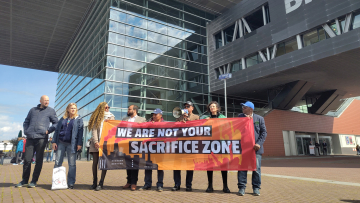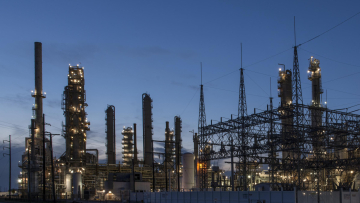
Project – On record
This profile is no longer actively maintained, with the information now possibly out of dateBankTrack
climate@banktrack.org

Project – On record
This profile is no longer actively maintained, with the information now possibly out of dateBankTrack
climate@banktrack.org
Why this profile?
The Driftwood LNG terminal, if fully realised, would have the capacity to produce and export 37 billion cubic metres of LNG every year, which is at odds with calls from international climate organisations such as the UN’s Intergovernmental Panel on Climate Change to reduce global LNG exports this decade to mitigate global warming. The Driftwood LNG terminal is also located in an area of Louisiana in which there are pre-existing air quality issues, according to data from the US Environmental Protection Agency.
What must happen
LNG export terminals are capital-intensive, financially risky and environmentally destructive. Financial institutions involved in these projects share responsibility for the impacts of these facilities. These impacts span people and ecosystems: communities around the terminal site, communities at the point of extraction and communities along pipeline routes.
By financing practices that are incompatible with a climate-stable future, the financial institutions involved threaten global agreements to address climate change. Therefore, Goldman Sachs and Société Générale, should withdraw their involvement as financial advisors to this project, and other banks should not provide project financing.
| Sectors | LNG Terminal |
| Location |
|
| Status |
Planning
Design
Agreement
Construction
Operation
Closure
Decommission
|
| Website | http://driftwoodlng.com/ |
Driftwood LNG is a proposed LNG export terminal in Calcasieu Parish, Louisiana sponsored by Tellurian Inc. The proposed 96-mile Driftwood LNG Pipeline, also sponsored by Tellurian Inc., would supply gas for the project. In March 2022, initial construction activities started on the project’s first phase, which is expected to cost at least USD 12 billion, although a final investment decision had not been taken and project financing was not secured.
Impact on human rights and communities
The Driftwood LNG terminal is sited in an area with pre-existing air quality issues, according to data from the US Environmental Protection Agency (EPA). The EPA’s EJSCREEN tool finds that the area within a three-mile radius of Driftwood LNG has EPA environmental indicators for fine particulate matter (PM 2.5), air toxics cancer risk, and respiratory hazard index that exceed the national medians.
Driftwood, like all LNG export facilities, would pose an immediate danger to the surrounding community. These terminals flare and vent noxious chemicals into the air, pollute nearby water sources, and can cause deadly accidents.
Impact on climate
The life cycle emissions from the Driftwood LNG terminal have been estimated to be 143 million tonnes of CO2 equivalent, evaluated on a 20-year timeframe, which is equivalent to the annual emissions of nearly 40 coal plants.
The overall cost for the project is estimated at USD 30 billion. A final investment decision for the project has yet to be taken and project finance loans have not been secured.
The project's financial advisors are Goldman Sachs and Société Générale, and the hoped for financing package would involve USD 7 billion in capital from the project partners and USD 20 billion in project finance debt for overall costs (IJGlobal).
In May 2019, the Swiss bank UBS provided Tellurian with USD 75 million in loans (one year tenor) for the project (IJGlobal). Credit Suisse said in April 2022 that it expects project financing for Driftwood to be finalised in the “coming months”, involving a combination of convertible preferred equity and debt.
In June 2022, Tellurian announced it would issue US$500 million in senior secured convertible notes. The following month, Tellurian stated it would release additional notes and make a public offering to raise funds for the project. However, in September 2022, Tellurian withdrew its senior notes offering and its stocks plunged 24%.
Project sponsor
Tellurian
United StatesOther companies
Bechtel
United StatesGunvor
Switzerland2023
2023-08-08 00:00:00 | All three supply deals terminated
After the LNG supply deals with Shell and Vitol fell through in September 2023, earlier this month in August the project's last remaining supply deal was terminated due to disagreement on the commercial terms with commodities trader Gunvor.
2022
2022-09-23 00:00:00 | Shell and Vitol terminate their purchase contracts with Tellurian
Following the failure of a US$1 billion high-yield bond sale earlier this month, Driftwood LNG promoter Tellurian has also seen Shell and global energy trader Vitol terminate their purchase agreement contracts for a total of 6 million tonnes per annum (mtpa) of LNG from its proposed export terminal facility in Louisiana. One agreement, with the commodity trader Gunvor, remains active for 3 mtpa of LNG. As a result, the company’s outspoken co-founder Charif Souki has recognized the need for a rethink of the company’s business model and accepted that Driftwood will be further delayed. In his latest YouTube video, Souki urged investors to now consider Tellurian “a solid American production company with very real domestic prospects”, with the ability to sell LNG globally as a “Holy Grail”. (GEM.wiki)
2022-09-21 00:00:00 | Tellurian to focus on finding equity partners for Driftwood LNG
Tellurian will now focus on finding equity partners for its Driftwood LNG export project in Louisiana after it withdrew a senior notes offering, according to the firm’s co-founder and executive chairman, Charif Souki. Due to uncertain conditions in the high-yield market, Tellurian withdrew the offering that would allowed the firm to stay on schedule to deliver LNG from Driftwood in the first half of 2026. Souki added that the company would continue with its plans, but staying on schedule would become “more difficult”.



